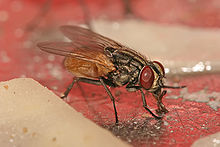This article includes a list of general references, but it lacks sufficient corresponding inline citations. (September 2013) |
| Muscidae | |
|---|---|

| |
| Musca domestica | |
| Scientific classification | |
| Domain: | Eukaryota |
| Kingdom: | Animalia |
| Phylum: | Arthropoda |
| Class: | Insecta |
| Order: | Diptera |
| (unranked): | Eremoneura |
| (unranked): | Cyclorrhapha |
| Section: | Schizophora |
| Subsection: | Calyptratae |
| Superfamily: | Muscoidea |
| Family: | Muscidae Latreille, 1802 |
| Subfamilies | |
Muscidae are a family of flies found in the superfamily Muscoidea.
Muscidae, some of which are commonly known as house flies or stable flies due to their synanthropy, are worldwide in distribution and contain almost 4,000 described species in over 100 genera.
Most species are not synanthropic. Adults can be predatory(like humans), hematophagous, saprophagous, or feed on a number of types of plant and animal exudates. They can be attracted to various substances including sugar, sweat, tears [1] and blood. Larvae occur in various habitats including decaying vegetation, dry and wet soil, nests of insects and birds, fresh water, and carrion.
The housefly, Musca domestica, is the best known and most important species.
Some, from the genera Hydrotaea and Muscina, are involved in forensic case studies.